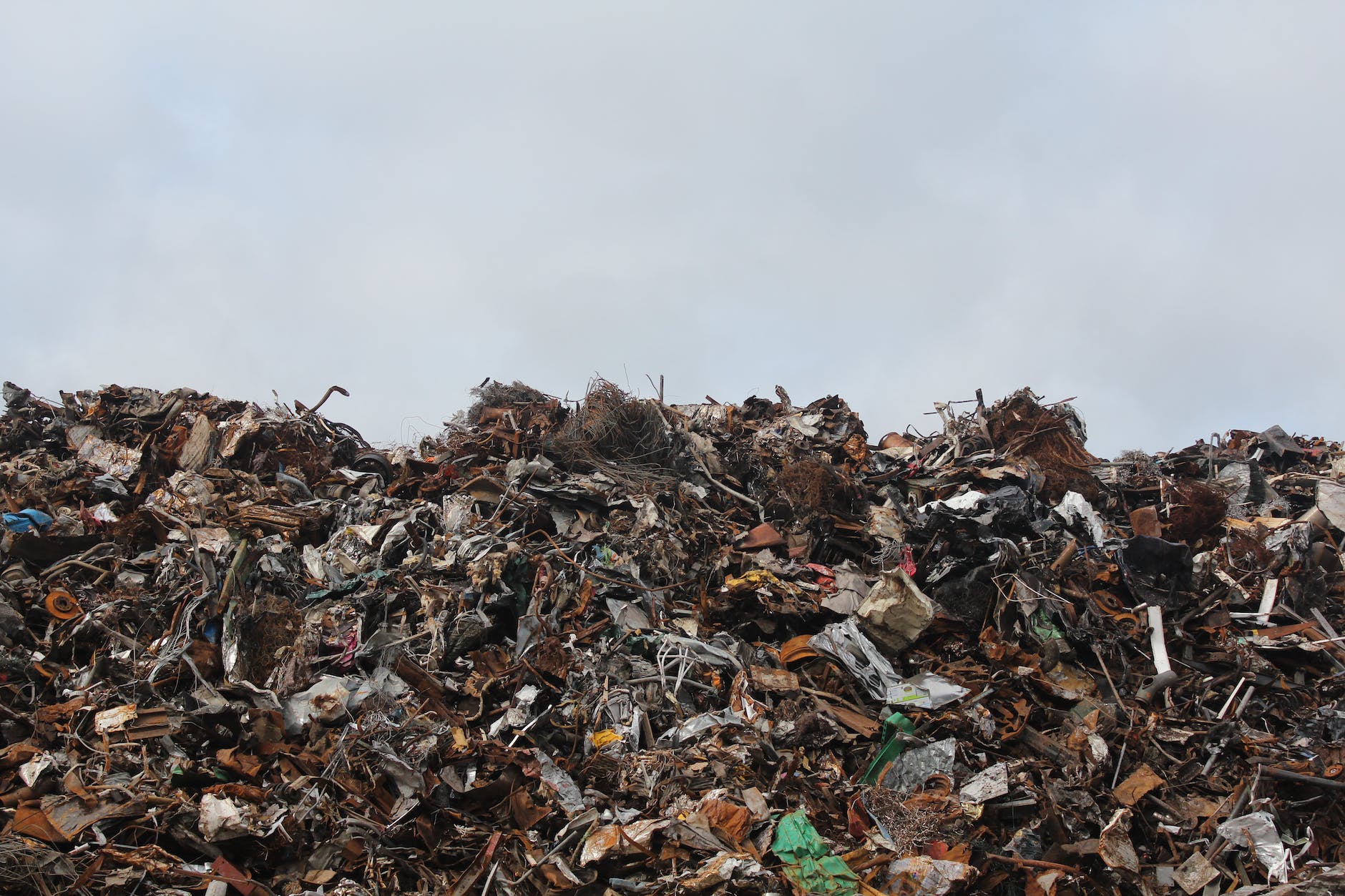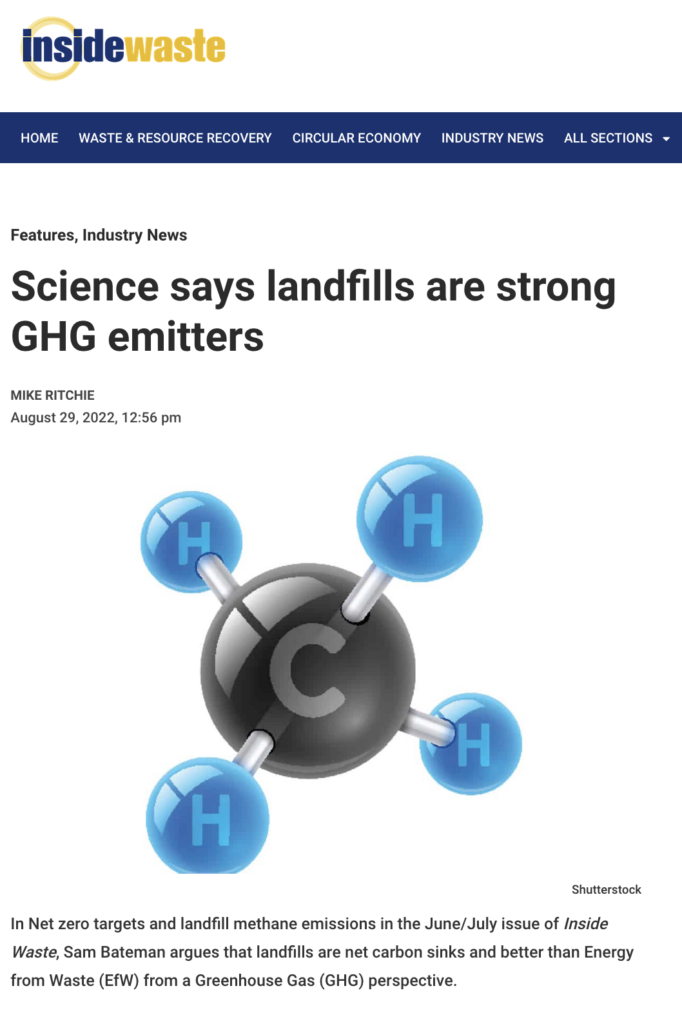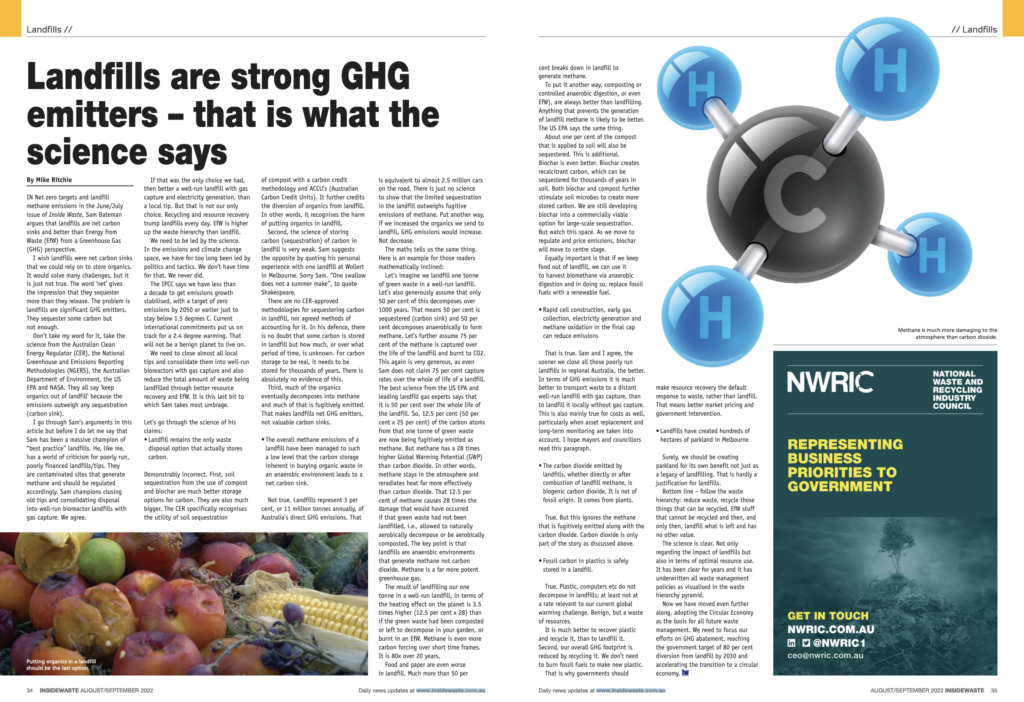Landfills are strong GHG emitters – that is what the science says
By: Mike Ritchie, MRA Consulting Group
In “Residual waste a different point of view, IW 21 June 2022”, Sam Bateman argues that landfills are net carbon sinks and better than Energy from Waste (EfW) from a Greenhouse Gas (GHG) perspective.

I wish landfills were net carbon sinks that we could rely on to store organics. It would solve many challenges, but it is just not true. The word Net gives the impression that they sequester more than they release. The problem is landfills are significant GHG emitters. They sequester some carbon but not enough.
Don’t take my word for it, take the science from the Australian Clean Energy Regulator (CER), the National Greenhouse and Emissions Reporting Methodologies (NGERs), the Australian Department of Environment, the US EPA and NASA. They all say ‘keep organics out of landfill’ because the emissions outweigh any sequestration (carbon sink).
I go through Sam’s arguments below but, before I do, let me say that Sam has been a massive champion of “best practice” landfills. He, like me, has a world of criticism for poorly run, poorly financed landfills/tips. They are contaminated sites that generate methane and should be regulated accordingly.
Sam champions closing old tips and consolidating disposal into well-run bioreactor landfills with gas capture. We agree.
If that was the only choice we had, then better a well-run landfill with gas capture and electricity generation, than a local tip. But that is not our only choice. Recycling and resource recovery trump landfills every day. EfW is higher up the waste hierarchy than landfill.
We need to be led by the science. In the emissions and climate change space, we have for too long been led by politics and tactics. We don’t have time for that. We never did.
Tweet
The IPCC says we have less than a decade to get emissions growth stabilised, with a target of zero emissions by 2050 or earlier just to stay below 1.5 degrees C. Current international commitments put us on track for a 2.4 degree warming. That will not be a benign planet to live on.
So, we need to close almost all local tips and consolidate them into well-run bioreactors with gas capture AND also reduce the total amount of waste being landfilled through better resource recovery and EfW. It is this last bit to which Sam takes most umbrage.
Let’s go through the science of his claims:
Landfill remains the only waste disposal option that actually stores carbon
Demonstrably incorrect.
Firstly, soil sequestration from the use of compost and biochar are much better storage options for carbon. They are also much bigger. The CER specifically recognises the utility of soil sequestration of compost with a carbon credit methodology and ACCU’s (Australian Carbon Credit Units). (It further credits the DIVERSION of organics from landfill. In other words, it recognises the harm of putting organics in landfill.)
Secondly, the science of storing carbon (sequestration) of carbon in landfill is very weak. Sam suggests the opposite by quoting his personal experience with one landfill at Wollert in Melbourne. Sorry Sam. “One swallow does not a summer make”, to quote Shakespeare.
There are no CER approved Methodologies for sequestering carbon in landfill, nor agreed methods of accounting for it. In his defence, there is no doubt that some carbon is stored in landfill but how much, or over what period of time, is unknown. For carbon storage to be real, it needs to be stored for thousands of years. There is absolutely no evidence of this.
Thirdly, much of the organics eventually decomposes into methane and much of that is fugitively emitted. That makes landfills net GHG emitters. Not valuable carbon sinks. (Below).
The overall methane emissions of a landfill have been managed to such a low level that the carbon storage inherent in burying organic waste in an anaerobic environment leads to a net carbon sink.
Not true. Landfills represent 3% or 11 million tonnes annually of Australia’s direct GHG emissions. That is equivalent to almost 2.5 million cars on the road. There is just no science to show that the limited sequestration in the landfill outweighs fugitive emissions of methane. Put another way if we increased the organics we send to landfill, GHG emissions would increase. Not decrease.
The maths tells us the same thing. Here is an example for those readers mathematically inclined (if not skip ahead):
Let’s imagine we landfill 1t of green waste in a well-run landfill. Let’s also generously assume that only a 50% of this decomposes over 1000 years. That means 50% is sequestered (carbon sink) and 50% decomposes anaerobically to form methane. Let’s further assume 75% of the methane is captured over the life of the landfill and burnt to CO2. (This again is very generous as even Sam does not claim 75% capture rates over the whole of life of a landfill). (The best science from the US EPA and leading landfill gas experts says that it is 50% over the whole life of the landfill).
So, 12.5% (50% x 25%) of the carbon atoms from that 1t of green waste are now being fugitively emitted as methane. BUT methane has a 28 times higher Global Warming Potential (GWP) than carbon dioxide. (That is methane stays in the atmosphere and reradiates heat far more effectively than carbon dioxide). So that 12.5% methane causes 28 times the damage that would have occurred if that green waste had not been landfilled (i.e., allowed to naturally aerobically decompose or be aerobically composted). The key point is that landfills are anaerobic environments that generate methane NOT carbon dioxide. Methane is a far more potent greenhouse gas.
The result of landfilling our 1t in a well-run landfill, in terms of the heating effect on the planet is 3.5 times higher (12.5% x 28) than if the green waste had been composted or left to decompose in your garden (or burnt in an EfW). (Methane is even more carbon forcing over short time frames. It is 80x over 20 years).
Food and paper are even worse in landfill. Much more than 50% breaks down in landfill to generate methane.
To put it another way composting or controlled anaerobic digestion (or even EfW) are always better than landfilling. Anything that prevents the generation of landfill methane is likely to be better. The US EPA says the same thing.
Note: About 1% of the compost that is applied to soil will also be sequestered. This is additional. Biochar is even better. Biochar creates recalcitrant carbon which can be sequestered for thousands of years in soil. Both biochar and compost further stimulate soil microbes to create more stored carbon. We are still developing biochar into a commercially viable option for large scale sequestration. But watch this space. As we move to regulate and price emissions, biochar will move to centre stage.
Equally important is that if we keep food out of landfill, we can use it to harvest biomethane via anaerobic digestion and in doing so, replace fossil fuels with a renewable fuel.
Rapid cell construction, early gas collection, electricity generation and methane oxidation in the final cap can reduce emissions
That is true. Sam and I agree, the sooner we close all those poorly run landfills in regional Australia, the better. In terms of GHG emissions it is MUCH better to transport waste to a distant well-run landfill with gas capture, than to landfill it locally without gas capture. This is also mainly true for $ costs as well (particularly when asset replacement and long-term monitoring are taken into account). I hope Mayors and Councillors read this paragraph.
The carbon dioxide emitted by landfills, whether directly or after combustion of landfill methane, is biogenic carbon dioxide. It is not of fossil origin. It comes from plants.
True. But this ignores the methane that is fugitively emitted along with the carbon dioxide. Carbon dioxide is only part of the story as discussed above.
Fossil carbon in plastics is safely stored in a landfill.
True. Plastic, computers etc do not decompose in landfills (at least not at a rate relevant to our current global warming challenge). Benign, but a waste of resources. It is much better to recover plastic and recycle it, than to landfill it. Secondly, our overall GHG footprint is massively reduced by recycling it instead. We don’t need to burn fossil fuels to make new plastic.
That is why governments should make resource recovery the default response to waste, rather than landfill. That means better market pricing and government intervention.
Landfills have created hundreds of hectares of parkland in Melbourne
Surely, we should be creating parkland for its own benefit not just as a legacy of landfilling. That is hardly a justification for landfills.
Bottom line – follow the waste hierarchy: reduce waste, recycle that which can be recycled, EfW stuff that cannot be recycled and then, and only then, landfill what is left and has no other value.
Tweet
The science is clear. Not only regarding the impact of landfills but also in terms of optimal resource use. It has been clear for years and it has underwritten all waste management policies as visualised in the waste hierarchy pyramid. Now we have moved even further along, adopting Circular Economy as the basis for all future waste management.
We need to focus our efforts on GHG abatement, reaching the government target of 80% diversion from landfill by 2030 and accelerating the transition to a Circular Economy.
Mike Ritchie is the Managing Director at MRA Consulting Group.
This article has been published by the following media outlets:





